This article has multiple issues. Please help improve it or discuss these issues on the talk page. (Learn how and when to remove these messages)
|
| 北京大学 | |||||||||||||||||||||||
 Seal Seal | |||||||||||||||||||||||
| Former names | Imperial University of Peking | ||||||||||||||||||||||
|---|---|---|---|---|---|---|---|---|---|---|---|---|---|---|---|---|---|---|---|---|---|---|---|
| Type | Public | ||||||||||||||||||||||
| Established | 1898; 127 years ago (1898) | ||||||||||||||||||||||
| President | Gong Qihuang | ||||||||||||||||||||||
| Party Secretary | Hao Ping | ||||||||||||||||||||||
| Academic staff | 11,337 | ||||||||||||||||||||||
| Students | 44,730 | ||||||||||||||||||||||
| Undergraduates | 16,060 | ||||||||||||||||||||||
| Postgraduates | 28,670 | ||||||||||||||||||||||
| Location | Haidian, Beijing, China 39°59′23″N 116°18′19″E / 39.98972°N 116.30528°E / 39.98972; 116.30528 | ||||||||||||||||||||||
| Campus | 274 ha (680 acres) | ||||||||||||||||||||||
| Colours | Red | ||||||||||||||||||||||
| Affiliations | C9, IARU, AALAU, AEARU, APRU, BESETOHA, BHUA | ||||||||||||||||||||||
| Website | pku.edu.cn english | ||||||||||||||||||||||
| Chinese name | |||||||||||||||||||||||
| Simplified Chinese | 北京大学 | ||||||||||||||||||||||
| Traditional Chinese | 北京大學 | ||||||||||||||||||||||
| |||||||||||||||||||||||
| Abbreviation | |||||||||||||||||||||||
| Chinese | 北大 | ||||||||||||||||||||||
| |||||||||||||||||||||||
Peking University (PKU) is a public university in Haidian, Beijing, China. It is affiliated with and funded by the Ministry of Education of China. The university is part of Project 211, Project 985, and the Double First-Class Construction. It is also a member in the C9 League.
Established as the Imperial University of Peking in 1898 by a royal charter from the Guangxu Emperor, it is the second oldest university in China after Tianjin University (established in 1895). In May 1912, the government of the Republic of China ordered the Imperial University of Peking to be renamed Peking University. Peking University merged with Yenching University after the nationwide restructuring of schools and departments in 1952. In April 2000, the former Beijing Medical University merged into the Peking University.
Peking University has six faculties, namely Humanities, Social Sciences, Economics and Management, Science, Information Technology and Engineering, as well as Health Science. It consists of 55 schools and departments, 60 research entities, and ten affiliated hospitals. By 2017, Peking University's staff include 76 academicians of the Chinese Academy of Sciences, 19 members of the Chinese Academy of Engineering and 25 members of the World Academy of Sciences.
History
| This section needs additional citations for verification. Please help improve this article by adding citations to reliable sources in this section. Unsourced material may be challenged and removed. Find sources: "Peking University" – news · newspapers · books · scholar · JSTOR (July 2021) (Learn how and when to remove this message) |

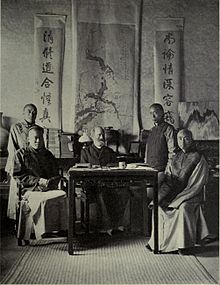 William Alexander Parson Martin, Dean of the Department of Western Learning with his students.
William Alexander Parson Martin, Dean of the Department of Western Learning with his students.
Establishment
Following China's defeat in the Sino-Japanese War, intellectuals – including Kang Youwei, Liang Qichao, and Yan Fu – called for reforms to the country's education system. In June 1896, Minister Li Duanfen proposed to create a university in the capital. On 11 June 1898, the Guangxu Emperor, as part of the Hundred Days' Reform, authorised the creation of the Imperial University of Peking (Chinese: 京師大學堂; pinyin: Jīngshī Dàxuétáng; lit. 'Capital Grand Study Hall'). The Imperial University was formally established on 3 July 1898 when the emperor approved the royal charter written by Liang. Minister Sun Jianai was charged with the implementation. IUP served as the country's foremost institute for higher learning, but also as its highest educational authority. William Alexander Parsons Martin was appointed as the first president. Most of the reforms were abolished when the conservative Empress Dowager Cixi seized power on 21 September. The university survived with altered objectives and reduced scope. It opened on 31 December with 160 students, instead of the planned 500.
Following the Xinhai Revolution, the Imperial University of Peking was renamed "Government University of Peking" in 1912 and then "National University of Peking" in 1919 (simplified Chinese: 国立北京大学; traditional Chinese: 國立北京大學; pinyin: Guólì Běijīng Dàxué).
Early Republic of China period (1916–1927)
The noted scholar Cai Yuanpei was appointed president on 4 January 1917, and helped transform Peking University into the country's largest institution of higher learning, with 14 departments and an enrollment of more than 2,000 students. President Cai, inspired by the German model of academic freedom, introduced faculty governance and democratic management to the university. Cai recruited an intellectually diverse faculty that included some of the most prominent figures in the progressive New Culture Movement, including Hu Shih, Liu Bannong, Ma Yinchu, Li Dazhao, Chen Duxiu, Lu Xun and Liang Shuming. Meanwhile, leading conservatives Gu Hongming and Huang Kan also taught at the university. A firm supporter for freedom of thought, Cai advocated for educational independence and resigned several times protesting the government's policy and interference.

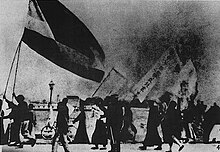
On 1 May 1919, some students of Peking University learned that the Treaty of Versailles would allow Japan to receive Germany's colonising rights in Shandong province. An assembly at Peking University that included these students and representatives from other universities in Beijing was quickly organised. On 4 May, students from thirteen universities marched to Tiananmen to protest the terms of Treaty of Versailles, demanded the Beiyang government to refuse to sign the treaty. Demonstrators also demanded the immediate resignation of three officials: Cao Rulin, Minister of the Ministry of Transportation, Zhang Zongxiang, China's Ambassador to Japan and Lu Zongyu, Minister of Currency, who they believed were in cooperation with Japanese. The protest ended up with some protesters being beaten and arrested, and Cao Rulin's house burned by protesters. Following the protest on 4 May, students, workers and merchants from nearly all China's major cities went on strike and boycotted Japanese goods in China. The Beiyang government eventually agreed to release the arrested students and fired the three officials under intense public pressure, China's representatives in Paris refused to sign the Treaty of Versailles.
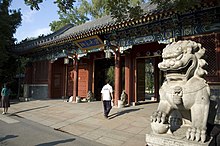
During the Criticize Lin, Criticize Confucius campaign of 1973 to 1976, critique groups formed at Peking University and Tsinghua University disseminated commentaries under the pseudonym of "Liang Xiao." The pseudonym sounds like a person's name but is a homophone for "two schools."
21st century (2000–present)
In October 2015, Peking University alumni Professor Tu Youyou was awarded the Nobel Prize in Physiology or Medicine for her discovery of artemisinin. Having saved millions of lives, artemisinin has made significant contributions to global health in regard to the fight against malaria.
On 20 February 2017, the university officially signed a contract with the British Open University to establish the Oxford Campus of Peking University HSBC Business School, Peking University Oxford Center and Shenzhen Oxford Innovation Center.
On 29 June 2020, the Sino-Russian Mathematics Center was established. The Sino-Russian Mathematics Center is led by Peking University and Moscow State University, and jointly constructed by relevant domestic units and other Russian universities and research institutes such as St. Petersburg University, relying on the "Double First-class" construction alliance in mathematics.
On 2 April 2021, Peking University Nanchang Innovation Research Institute was inaugurated.
On 15 July 2021, Peking University School of Integrated Circuits was inaugurated.
On 6 September 2021, the new Changping campus of Peking University was officially opened, welcoming the first batch of teachers and students. On 30 September, Peking University Lanyuan Centre was officially launched. The first dean of Lanyuan Centre is Ke Yang, Professor of Peking University School of Clinical Oncology and a foreign academician of the American Academy of Medical Sciences. In October, Peking University officially announced the establishment of Peking University School of Computer Science, which means the computer major of Peking University was officially upgraded from a department to a school. Yang Fuqing, Academician of the Chinese Academy of Sciences, served as the honorary president.
In 2022, Peking University and Lancet established a commission on healthy aging in China. The Commission's purpose is to re-focus the debate on aging not just on the risks of China's aging population but on opportunities by "unleashing the intellectual and vocational capacities of the older population and the whole of Chinese society."
In June 2022, the International University Sports Federation (FISU) released the first series of "Healthy Campus" list. Peking University, as the only Chinese university that has obtained platinum certification from the International University Sports Federation, participated in 4 projects and became the only representative from China among 130 projects worldwide.
Campus

American architect and art historian Talbot Hamlin designed some of the university's buildings constructed during the 1919 to 1922 period. There are several gates that lead into campus — East, West and South gates, with the West Gate being the most well known for the painted murals on its ceiling. Weiming Lake is in the north of the campus and is surrounded by walking paths and small gardens. The university hosts many museums, such as the Museum of University History and the Arthur M. Sackler Museum of Art and Archaeology. Notable items in these museums include funerary objects that were excavated in Beijing and date back thousands of years from the graves of royals of the Warring States period. There are ritual pottery vessels as well as elaborate pieces of jewelry on display. There are also human bones set up in the traditional burial style of that period.
Beyond its main campus, Peking University Health Science Center (PKUHSC) is on Xueyuan Road where the country's most distinguished colleges are, and is a fitting site for academics and research.
During the Third Front construction, Peking University opened a branch in Hanzhong, Shaanxi.
In 2001, Peking University's Shenzhen campus, the Shenzhen Graduate School, opened its doors. The campus is located in the northwest part of Shenzhen City.
-
 Peking University during winter. The campus is situated on a former imperial garden.
Peking University during winter. The campus is situated on a former imperial garden.
-
 Peking University during the autumn
Peking University during the autumn
-
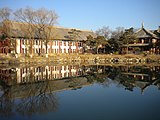 The College of Architecture and Landscape
The College of Architecture and Landscape
-
 Boya Pagoda
Boya Pagoda
-
 The Humanities Buildings
The Humanities Buildings
-
 A stone bridge inside the campus
A stone bridge inside the campus
-
 A gymnasium building
A gymnasium building
-
 Peking University West Gate
Peking University West Gate
-
 Peking University's Main Library
Peking University's Main Library
-
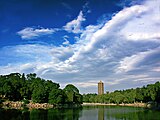 Weiming Lake occupies the central part of the campus of Peking University
Weiming Lake occupies the central part of the campus of Peking University
-
 The old site of the Ciji Temple at the Weiming Lake
The old site of the Ciji Temple at the Weiming Lake
-
 Peking University's Science Teaching Building
Peking University's Science Teaching Building
-
 School of International Studies
School of International Studies
-
 College of Chemistry and Molecular Engineering
College of Chemistry and Molecular Engineering
-
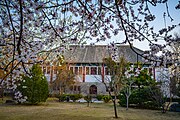 Peking University during the spring. Flowers are blooming everywhere.
Peking University during the spring. Flowers are blooming everywhere.
-
 School of Archaeology and Museology
School of Archaeology and Museology
-
Arthur M. Sackler Museum of Arts and Archaeology
-
 Department of History
Department of History
-
 School of Life Sciences
School of Life Sciences
-
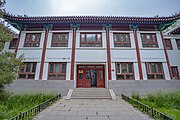 Beijing International Center for Mathematical Research
Beijing International Center for Mathematical Research
-
 Department of Chinese Language and Literature
Department of Chinese Language and Literature
Academics
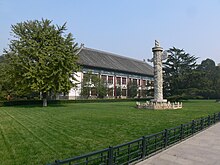
Peking University consists of 30 schools and 12 departments, with 125 majors for undergraduates, 2 majors for the second bachelor's degree, 282 programs for Master's degree candidates and 258 programs for doctoral candidates. In addition to basic research, the university also conducts applied research.
At present, Peking University has 216 research institutions and research centres, including 2 national engineering research centers, 81 key national disciplines, and 12 national key laboratories. With 8 million holdings, the university library is the largest of its kind in Asia.
Peking University, the Georgia Institute of Technology, and Emory University jointly administer the Wallace H. Coulter Department of Biomedical Engineering.
Over the past century, some Peking University alumni have become presidents of other major Chinese universities, including former Tsinghua President Luo Jialun, Renmin University President Yuan Baohua, Zhejiang University President Qian Sanqiang, Fudan University President Zhang Zhirang, Nankai University President Teng Weizao, Chinese University of Science and Technology President Guan Weiyan and many others.
Rankings and reputation
General rankings
| University rankings | |
|---|---|
| Global – Overall | |
| ARWU World | 24 |
| QS World | 14 |
| QS Employability | 23 |
| THE World | 13 |
| THE Reputation | 11 |
| USNWR Global | 31 |
| Regional – Overall | |
| ARWU Asia | 2 |
| QS Asia | 1 |
| QS BRICS | 2 |
| THE Asia | 2 |
| THE Emerging Economies | 1 |
Several rankings have placed Peking University among the top universities in mainland China. In 2015, the Chinese University Alumni Association in partnership with China Education Center considered it first among all Chinese universities.
As of 2024, Peking University was ranked the best in the Asia-Pacific and the 16th worldwide in terms of aggregate performance (THE+ARWU+QS) as reported by the Aggregate Ranking of Top Universities.
The joint THE-QS World University Rankings 2005 & 2006 ranked Peking University 1st in the Asia & Oceania region and 14th in the world in 2006. In 2014, the U.S. News & World Report ranked Peking University 39th in the world, 2nd in the Asia-Pacific and 1st in China. Peking had topped the newly launched Times Higher Education BRICS & Emerging Economies since its inception in 2014.
The 2023 QS Rankings ranked Peking University 12th in the world and first in Asia. As of 2024, the Times Higher Education World University Rankings ranked Peking University 13th in the world, with its teaching and research environment indicators placed at 9th and 7th in the world respectively. Peking University was also ranked 15th in the world and 1st in the Asia-Pacific in The Three University Missions Ranking. The Academic Ranking of World Universities, also known as the "Shanghai Ranking", placed Peking University 24th in the world and 2nd in the Asia-Pacific & China. The U.S. News & World Report ranked Peking University 31st in the world, 4th in Asia and 2nd in China.
In the QS Graduate Employability Rankings 2017, an annual ranking of university graduates' employability, Peking University was ranked 11th in the world and 2nd in Asia. In 2019, the QS World University Rankings ranked the university as one of the world's top 20 universities for academic reputation where, it ranked 16 globally, and top 10 in the world and first in the Asia-Pacific for employer reputation. Since 2017, Peking has been placed among the world's top 20 most reputable universities by the Times Higher Education World Reputation Rankings, where it ranked 11 globally in 2023.
Research Performance
The 2020 CWTS Leiden Ranking ranked Peking University at 8th in the world based on their publications for the time period 2015–2018. For the high quality of research in natural science and health science, Peking University ranked 6th among the leading institutions, and 4th among the leading universities globally in the Nature Index 2024 Research Leaders by Nature Research. In 2023, it ranked 8th among the universities around the world by SCImago Institutions Rankings. In November 2024, Clarivate Analytics ranked Peking University 12th in the world for most Highly Cited Researchers.
Subjects Rankings
|
| |||||||||||||||||||||||||||||||||||||||||||||||||||||||||||||||||||||||||||||||||||||||||||||||||||||||||||||||||||||||||||||||||||||||||||||||||||||||||||||||||||||||||||||||||||||||||||||||||||||||||||||||||||||||||||||||||||||||||||||||||||||||||||||||||||||||||||||||||||||||||||||||||||||||||||||||||||||||||||||||||||||||
List of schools
| Faculty of Sciences | |||
| School of Mathematical Sciences | School of Physics | College of Chemistry and Molecular Engineering | School of Life Sciences |
| College of Urban and Environmental Sciences | School of Earth and Space Sciences | School of Psychological and Cognitive Sciences | College of Architecture and Landscape Architecture |
| Faculty of Information and Engineering | |||
| School of Electronics Engineering and Computer Science | College of Engineering | Institute of Computer Science and Technology | School of Software and Microelectronics |
| College of Environmental Sciences and Engineering | National Engineering Research Center for Software Engineering* | Wangxuan Institute of Computer Technology | School of Materials Science and Engineering |
| College of Future Technology | |||
| Faculty of Humanities | |||
| Department of Chinese Language and Literature* | Department of History | School of Archaeology and Museology | Department of Philosophy and Religious Studies |
| School of Foreign Languages | School of Arts | School of Chinese as a Second Language | Academy of Opera |
| Faculty of Social Sciences | |||
| School of International Studies | Law School | Department of Information Management | Department of Sociology |
| School of Government | School of Marxism | Graduate School of Education | School of Journalism and Communication |
| Department of PE | |||
| Faculty of Economics and Management | |||
| School of Economics | Guanghua School of Management | Institute of Population Research | National School of Development |
| Peking University Health Science Center | |||
| School of Basic Medical Sciences | School of Pharmaceutical Sciences | School of Public Health | School of Nursing |
| School of Health Humanities | School of Continuing Medical Education* | Peking University First Hospital | Peking University People's Hospital |
| Peking University Third Hospital | Peking University Hospital of Stomatology | Peking University Sixth Hospital | Peking University Cancer Hospital |
| Peking University Shenzhen Hospital | Peking University Shougang Hospital | Peking University International Hospital | Peking University BinHai Hospital |
| Interdisciplinary | |||
| Yuanpei College (undergraduate liberal arts) | Yenching Academy | Academy for Advanced Interdisciplinary Studies | Institute of Molecular Medicine |
| The Kavli Institute for Astronomy and Astrophysics | Institute of Nuclear Sciences and Technology | Beijing International Center for Mathematical Research | School of Advanced Agricultural Sciences |
| Shenzhen Graduate School | |||
| School of Electronic and Computer Engineering | School of Chemical Biology and Biotechnology | School of Environment and Energy* | School of Urban Planning and Design |
| School of Advanced Materials | HSBC Business School | School of Transnational Law | School of Humanities and Social Sciences |
| Peking University Shenzhen Graduate School | |||
Library
On 24 October 2018, Peking University Library, the largest library among Asian universities, held the opening ceremony of the 120th anniversary at the Yingjie Overseas Exchange Center.
National School of Development
The National School of Development (formerly China Center for Economic Research) is ranked amongst the top five most influential think tanks in China.
In 1998, Justin Yifu Lin et al. jointly founded the Beijing International MBA at Peking University (BiMBA), which is ranked among the top six MBA programs by Quacquarelli Symonds in its TopMBA ranking of the best MBA programs in Asia Pacific for the year 2014–2015. BiMBA has also been ranked as the second most valuable full-time MBA in China by Forbes (after CEIBS) and among Asia's best business schools by Bloomberg Business.
Shenzhen Graduate School
Main article: Peking University Shenzhen Graduate School
Peking University Shenzhen Graduate School is a satellite campus of Peking University located in Shenzhen, Guangdong. It was founded in September 2001 in collaboration with the Shenzhen Municipal Government and is located in University Town of Shenzhen along with satellite campuses of Tsinghua University and Harbin Institute of Technology. Dr. Wen Hai, a renowned economist in China and the vice-president of Peking University is the present chancellor of PKU Shenzhen. The school houses seven research departments as well as the Peking University HSBC Business School and Peking University School of Transnational Law.
On 29 August 2016, Peking University signed a strategic agreement with the Shenzhen Municipal Government to further develop its Shenzhen Graduate School, the university plans build a brand new campus near the existed graduate school and open undergraduate programs.
International cooperation

Every year, there are approximately 7,000 international students studying at Peking University.
Peking University offers dual degree programs at the bachelor's, master's, and doctoral levels with the renowned Waseda University (早稲田大学) in Northeast Asia. It is one of the most engaged partners with Waseda, having established a strong cooperative relationship of the highest level. This partnership began with an academic agreement in 1982, enhancing dual degree programs and joint research initiatives since 2003. Under the PKU-Waseda project, each year, the university selects undergraduates to spend their third year studying at Waseda University in Japan, and then they return to Peking University for their fourth year. Simultaneously, Waseda University sends numerous students to Peking University as exchange students. Upon graduation, students receive two bachelor's degrees, one from each university. Additionally, joint master's student training programs and dual doctoral degree programs with Waseda University are also in operation. The comprehensive collaboration of offering dual degrees at all bachelor's, master's, and doctoral levels, as seen in the Peking-Waseda partnership, is rare on a global scale.
The dormitories for international students at the main campus are located at Shaoyuan Garden (勺园) and Zhongguanyuan Global Village (中关新园). Its international students are made up of students from most countries in the world including most of Western Europe, North America, and South America, Asia, Australia and many countries in Africa. In 2005, Peking University and Cornell University signed an agreement formally establishing the China and Asia-Pacific Studies major at Cornell, which requires students to spend a semester studying at Peking University while working at internships. In 2006, PKU launched a joint undergraduate program with Yale University in which students will spend a semester overseas, living and studying together with the host institute's students. PKU's School of International Studies also launched joint degree programs with London School of Economics, Paris School of International Affairs, Seoul National University, and the University of Tokyo. PKU also has a longstanding relationship with Stanford University which operates a joint research center and base for Stanford students and scholars at the Stanford Center at Peking University, located in the Lee Jung Sen Building. The Peking University HSBC Business School has joint degree programs with University of Hong Kong and Chinese University of Hong Kong. The university has maintained a partnership with the Freie Universität Berlin since 1981 and the Higher School of Economics since 2015, and in 2019, became a partner of Washington University in St. Louis through the McDonnell International Scholars Academy.
Global excellence strategy
On the 121st founding anniversary, Peking University unveiled the "Global Excellence Strategy", an international blueprint aiming to enhance Peking University's global presence during the "Fourth Industrial Revolution". The "Global Excellence Strategy" aims to strengthen international cooperation, overcome development barriers, gather global resources, and stimulate collegial relationships. The Global Excellence Strategy is based upon the English word "CLOUDS", representing the "cloud era" of the "Fourth Industrial Revolution". Each letter stands for a corresponding word, namely creativity, leadership, openness, uniqueness, diversity and shaping.
Art research

Peking University has participated in many joint art-research projects, such as the Center for the Art of East Asia (CAEA) with the University of Chicago, and Department of Digital Art and Design with UNESCO.
Notable people
For a more comprehensive list, see List of Peking University people.
Notable alumni
Notable alumni include the current chairman of the Standing Committee of the National People's Congress and the third-ranking member of the CCP Politburo Standing Committee Zhao Leji. Other alumni in politics include former premier of China Li Keqiang, former vice premier of China Hu Chunhua, former minister of Education, Chen Baosheng; current Chief Executive of Macao, Sam Hou Fai; former minister of Natural resources, Wang Guanghua; current Minister of the United Front Work Department, Shi Taifeng, former Governor of the Central Bank of China, Yi Gang, former Interpol-president, Meng Hongwei, and former minister of commerce and Communist Party Secretary of Chongqing, Bo Xilai.
Notable alumni in the sciences include Nobel laureate Tu Youyou, who for her work in discovering artemisinin and dihydroartemisinin used to treat malaria, was awarded the Nobel Prize in Physiology or Medicine jointly with William C. Campbell and Satoshi Ōmura; nuclear physicists and contributors to Chinese nuclear weapons program Qian Sanqiang and Deng Jiaxian, and "father of the Chinese hydrogen bomb" physicist Yu Min, nuclear physicist Zhu Guangya, particle physicist and discoverer of the partial conservation of the axial current, Zhou Guangzhao; mathematician and MacArthur Fellow Yitang Zhang, neurosurgeon Wang Zhongcheng, pulmonologist and recipient of the Medal of the Republic, Zhong Nanshan, and chief economist of the World Bank, Justin Yifu Lin.
Notable alumni in the humanities and arts include author Lu Xun, philosopher and essayist Hu Shih, polymath Lin Yutang, philosopher Liang Shuming, Qing-dynasty educator Gu Hongming, anthropologist Fei Xiaotong, translator Li Bulou, computer scientist Wang Xuan, and author Jin Yong. Notable international alumni include emeritus professor and linguist Michael Halliday, author Julia Ebner, and philosopher Professor Li Chenyang.
Notable alumni in business include co-founder and CEO of Baidu, billionaire Robin Li, and cryptocurrency entrepreneur Justin Sun.
Other notable alumni include chess grandmaster, four-time Women's World Chess Champion, and Rhodes Scholar Hou Yifan.
-
 Gu Hongming, translator and educator.
Gu Hongming, translator and educator.
-
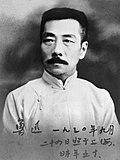 Lu Xun, leading figure of modern Chinese literature.
Lu Xun, leading figure of modern Chinese literature.
-
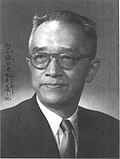 Hu Shih, influential Chinese philosopher and essayist.
Hu Shih, influential Chinese philosopher and essayist.
-
 Lin Yutang, Chinese writer, linguist, inventor, and translator.
Lin Yutang, Chinese writer, linguist, inventor, and translator.
-
 Liang Shuming, philosopher.
Liang Shuming, philosopher.
-
 Nuclear physicist and key contributor to the Chinese nuclear weapon program Deng Jiaxian.
Nuclear physicist and key contributor to the Chinese nuclear weapon program Deng Jiaxian.
-
 Fei Xiaotong, sociologist and anthropologist.
Fei Xiaotong, sociologist and anthropologist.
-
 Nuclear physicist and leading organizer of the Chinese nuclear weapon program, Qian Sanqiang.
Nuclear physicist and leading organizer of the Chinese nuclear weapon program, Qian Sanqiang.
-
 Former Premier of China, Li Keqiang (LLB, PhD)
Former Premier of China, Li Keqiang (LLB, PhD)
-
 Nobel laureate Tu Youyou, pharmaceutical chemist and educator, recipient of the 2015 Nobel Prize in Physiology or Medicine.
Nobel laureate Tu Youyou, pharmaceutical chemist and educator, recipient of the 2015 Nobel Prize in Physiology or Medicine.
-
 Co-founder and CEO of Baidu, billionaire Robin Li (BSc, Information Management, 1991)
Co-founder and CEO of Baidu, billionaire Robin Li (BSc, Information Management, 1991)
-
 Four-time Women's World Chess Champion, Hou Yifan (BA, International Relations, 2018)
Four-time Women's World Chess Champion, Hou Yifan (BA, International Relations, 2018)
-
 World Chess Champion and highest-rated Chinese chess player in history, Ding Liren (BA, Law)
World Chess Champion and highest-rated Chinese chess player in history, Ding Liren (BA, Law)
-
 Mathematician and MacArthur Fellow Yitang Zhang (BA 1982, MA 1984)
Mathematician and MacArthur Fellow Yitang Zhang (BA 1982, MA 1984)
-
 Philosopher, national debate champion, co-founder and CEO of Kippa, Kennedy Ekezie (MA, Economics and Management)
Philosopher, national debate champion, co-founder and CEO of Kippa, Kennedy Ekezie (MA, Economics and Management)
Notable academics and staff
Peking University has benefited from the services of notable academics and staff. These include founder of the People's Republic of China Mao Zedong (who worked as a library staff at the university), educator, politician, and revolutionary Cai Yuanpei (served as Chancellor of Peking University), and others.
See also
Portals:- 7072 Beijingdaxue – asteroid named after Peking University
- Affiliated High School of Peking University
- Beijing Guozijian
- China Family Panel Studies
- History of Beijing
Notes
- Although Mao audited classes while working at PKU, he was not a formally enrolled student and did not graduate from the university.
References
- "History Peking University". Peking University. Archived from the original on 16 July 2015. Retrieved 15 July 2015.
- ^ "北京大学2018年基本数据" (PDF). December 2018. Archived (PDF) from the original on 27 January 2021. Retrieved 27 September 2020.
- "About PKU, General Information". Peking University. Archived from the original on 17 May 2018. Retrieved 17 May 2018.
- ^ "ABOUT-PKU HISTORY". Peking University. 2023.
- "北京大学基本数据" [Peking University Basic Statistics] (PDF). Peking University. 2017. Archived (PDF) from the original on 28 January 2021.
- ^ Peking University. "From Imperial University of Peking to Peking University in the Early Years of Republic of China". Archived from the original on 16 November 2020. Retrieved 30 November 2020.
- ^ "[Anniversary Special] "In the beginning was the word"". Peking University. 2 May 2011. Archived from the original on 13 November 2017. Retrieved 9 September 2017.
- A companion to Asian art and architecture. Brown, Rebecca M., Hutton, Deborah S. Chichester, West Sussex, UK: Wiley-Blackwell. 2011. ISBN 9781444396355. OCLC 767516261.
{{cite book}}: CS1 maint: others (link) - Goldman, René (1961). "Peking University Today". The China Quarterly. 7: 101–111. doi:10.1017/S0305741000025054. ISSN 1468-2648.
- "World Policy Journal – Summer 2005 – World Policy". World Policy. Archived from the original on 1 July 2018. Retrieved 11 May 2018.
- ^ Xu, Youwei; Wang, Y. Yvon (2022). Everyday Lives in China's Cold War Military Industrial Complex: Voices from the Shanghai Small Third Front, 1964–1988. Palgrave MacMillan. p. 238. ISBN 9783030996871.
- Su, Xin-zhuan; Miller, Louis H. (2015). "The discovery of artemisinin and Nobel Prize in Physiology or Medicine". Science China Life Sciences. 58 (11). US National Library of Medicine National Institutes of Health: 1175–1179. doi:10.1007/s11427-015-4948-7. PMC 4966551. PMID 26481135.
- "PHBS opening a campus in UK: a turning point for China's higher education". PKU News. Peking University HSBC Business School. 28 February 2017. Archived from the original on 13 November 2020. Retrieved 28 September 2020.
- "Chinese, Russian universities hold virtual meeting on coopereation". Xinhua. 3 December 2021. Archived from the original on 26 September 2022. Retrieved 26 September 2022.
- "中俄数学中心". srmc.pku.edu.cn. Archived from the original on 26 September 2022. Retrieved 26 September 2022.
- "北京大学南昌创新研究院揭牌 刘强邱水平共同揭牌 万广明主持仪式". cnews.chinadaily.com.cn. 3 April 2021. Archived from the original on 26 September 2022. Retrieved 26 September 2022.
- Che Pan (16 July 2021). "Peking University joins country's wave to create new semiconductor schools". South China Morning Post. Archived from the original on 26 September 2022. Retrieved 26 September 2022.
- Peking University (29 September 2021), "Lanyuan Centre | Empowering Women through Educatio", YouTube, archived from the original on 26 September 2022, retrieved 26 September 2022
- "Overview". School of Computer Science Peking University. Archived from the original on 26 September 2022. Retrieved 26 September 2022.
- "Academia Related to both China and Software Engineering". Tao Xie's Homepage. Archived from the original on 18 January 2022. Retrieved 26 September 2022.
- ^ Bachulska, Alicja; Leonard, Mark; Oertel, Janka (2 July 2024). The Idea of China: Chinese Thinkers on Power, Progress, and People (EPUB). Berlin, Germany: European Council on Foreign Relations. ISBN 978-1-916682-42-9. Archived from the original on 17 July 2024. Retrieved 22 July 2024.
- Barker, Philip (27 May 2022). ""Healthy" universities honoured by FISU". insidethegames.biz. Archived from the original on 26 September 2022. Retrieved 26 September 2022.
- "Talbot F. Hamlin (1889–1956)". Columbia University Libraries. Archived from the original on 24 June 2019. Retrieved 19 August 2020.
- "Arthur M. Sackler Museum of Art & Archaeology". Archived from the original on 11 April 2011.
- ^ "A destination to be explored". Archived from the original on 3 March 2016. Retrieved 15 July 2015.
- Marquis, Christopher; Qiao, Kunyuan (2022). Mao and Markets: The Communist Roots of Chinese Enterprise. New Haven: Yale University Press. doi:10.2307/j.ctv3006z6k. ISBN 978-0-300-26883-6. JSTOR j.ctv3006z6k. OCLC 1348572572. S2CID 253067190.
- "北京大学2018年基本数据" (PDF). 北京大学. December 2018. Archived (PDF) from the original on 27 January 2021. Retrieved 28 September 2020.
- Harvard News Office. "Harvard Gazette: Summers visits People's Republic of China". Archived from the original on 8 December 2015. Retrieved 15 July 2015.
- "Georgia Tech / Emory / Peking University BME PhD Program". Archived from the original on 14 October 2016. Retrieved 19 January 2015.
- "Centers, Institutes, & Partners | Emory University | Atlanta GA". www.emory.edu. Archived from the original on 1 November 2021. Retrieved 7 January 2022.
- Club Yahoo!
- "ARWU World University Rankings 2024 – Academic Ranking of World Universities 2024 – Top 1000 universities – Shanghai Ranking – 2024". www.shanghairanking.com. Archived from the original on 15 August 2023. Retrieved 15 August 2024.
- "QS World University Rankings 2025". 5 June 2024. Archived from the original on 8 June 2022. Retrieved 5 June 2024.
- "GER 2022". Top Universities. Archived from the original on 5 October 2021. Retrieved 15 August 2022.
- ^ "Peking University". Times Higher Education (THE). 9 October 2024. Retrieved 9 October 2024.
- "World Reputation Rankings 2023". 13 February 2024. Retrieved 13 February 2024.
- "US News Best Global Universities Rankings 2024–2025". Archived from the original on 26 October 2021. Retrieved 25 June 2024.
- "ARWU World University Rankings 2024 – Academic Ranking of World Universities 2024 – Top 1000 universities – Shanghai Ranking – 2024". www.shanghairanking.com. Archived from the original on 15 August 2023. Retrieved 15 August 2024.
- ^ "QS Asia University Rankings 2023 – Overall". Top Universities. Archived from the original on 5 December 2022. Retrieved 9 November 2022.
- "BRICS 2019". Top Universities. Archived from the original on 20 January 2021. Retrieved 27 September 2020.
- "THE Emerging University Rankings 2022". 15 October 2021. Archived from the original on 4 November 2021. Retrieved 5 November 2021.
- ^ www.sicas.cn. "University in China.Best Universities in China". sicas.cn. Archived from the original on 19 October 2021. Retrieved 22 April 2012.
- ^ "QS World University Rankings 2023: Top Global Universities". Top Universities. Archived from the original on 8 June 2022. Retrieved 15 August 2022.
- "2016 China University Ranking by Alumni Association". CUCAS. Archived from the original on 30 April 2018. Retrieved 30 April 2018.
- "University Results | Rankings". research.unsw.edu.au. Retrieved 17 December 2024.
- "Times Higher Education: WORLD UNIVERSITY RANKINGS 2006". www.timeshighereducation.co.uk. 6 October 2006. Archived from the original on 4 March 2008.
- "US News Best Global Universities Rankings: Peking University". U.S. News & World Report. Archived from the original on 31 October 2014.
- "BRICS & Emerging Economies Rankings 2014". Times Higher Education. Archived from the original on 18 March 2015. Retrieved 2 October 2014.
- "Emerging Economies Ranking 2019". Times Higher Education (THE). 15 January 2019. Archived from the original on 25 February 2019. Retrieved 2 December 2020.
- "Peking University". Top Universities. Archived from the original on 1 July 2019. Retrieved 6 November 2019.
- "World University Rankings". Times Higher Education (THE). 4 October 2024. Retrieved 9 October 2024.
- "俄2020年国际大学排名出炉!中国122所高校入围,仅次于美国排名第二". pkunews.pku.edu.cn. Archived from the original on 11 October 2020. Retrieved 4 October 2020.
- "ShanghaiRanking's Academic Ranking of World Universities". www.shanghairanking.com. Archived from the original on 15 August 2024. Retrieved 15 August 2024.
- "Peking University". US News & World Report. Archived from the original on 26 October 2021. Retrieved 25 June 2024.
- "Graduate Employability Rankings 2017". Top Universities. 5 November 2015. Archived from the original on 2 October 2017. Retrieved 3 December 2020.
- "QS World University Rankings 2019 – Rankings Indicators, Academic Reputation". Top Universities. Archived from the original on 8 June 2018. Retrieved 23 April 2022.
- "QS World University Rankings 2019 – Rankings Indicators, Employer Reputation". Top Universities. Archived from the original on 8 June 2018. Retrieved 23 April 2022.
- "World Reputation Rankings". Times Higher Education (THE). 29 January 2024. Archived from the original on 13 February 2024. Retrieved 13 February 2024.
- Studies (CWTS), Centre for Science and Technology. "CWTS Leiden Ranking". CWTS Leiden Ranking. Archived from the original on 2 February 2011. Retrieved 17 September 2020.
- "2024 Research Leaders: Leading institutions | Nature Index". www.nature.com. Archived from the original on 23 June 2024. Retrieved 19 June 2024.
- "University Rankings 2023". www.scimagoir.com. Archived from the original on 19 June 2024. Retrieved 19 June 2024.
- "Highly Cited Researchers – Analysis – 2024 | Clarivate". clarivate.com. 13 November 2024. Retrieved 20 November 2024.
- "QS World University Rankings by Subject 2024". QS World University Rankings. Archived from the original on 8 September 2024. Retrieved 24 April 2024.
- "World University Rankings by subject". Times Higher Education World University Rankings. Archived from the original on 1 March 2020. Retrieved 24 February 2021.
- "ShanghaiRanking's Global Ranking of Academic Subjects 2023". Academic Ranking of World Universities. Archived from the original on 10 February 2024. Retrieved 24 April 2024.
- "北京大学信息科学技术学院". eecs.pku.edu.cn. Archived from the original on 21 August 2023. Retrieved 21 August 2023.
- "北京大学计算机科学技术研究所". www.icst.pku.edu.cn. Archived from the original on 11 October 2022. Retrieved 11 October 2022.
- "Department of Philosophy and Religious Studies, Peking University". en.phil.pku.edu.cn. Archived from the original on 11 October 2022. Retrieved 11 October 2022.
- "Peking University International Hospital, Beijing". www.cchsu.com.tw. Archived from the original on 11 October 2022. Retrieved 11 October 2022.
- "Peking University Shenzhen Graduate School (PKU Shenzhen)-Sustainable Development Research Institute". sisd.org.cn. Archived from the original on 11 October 2022. Retrieved 11 October 2022.
- "[120th Anniversary of PKU Library] PKU Library celebrates her 120th anniversary". newsen.pku.edu.cn. Archived from the original on 23 August 2022. Retrieved 23 August 2022.
- "China Network– Peking University's National School of Development: The Brains behind China's growth". Archived from the original on 3 July 2015. Retrieved 15 July 2015.
- "National School of Development ranks in top five Think Tanks for Highest Professional Influence_Peking University". Archived from the original on 3 July 2015. Retrieved 15 July 2015.
- "The Top 10 Business Schools in Asia-Pacific 2014/15". TopMBA.com. Archived from the original on 8 July 2015. Retrieved 15 July 2015.
- Russell Flannery & Chloe Chen (26 April 2010). "China's Best Business Schools". Forbes. Archived from the original on 17 July 2015. Retrieved 15 July 2015.
- Frederik Balfour; Bruce Einhorn; Moon Ihlwan; Mehul Srivastava & Hiroko Tashiro. "Asia's Top Business Schools". Businessweek.com. Archived from the original on 11 July 2015. Retrieved 15 July 2015.
- "Keeping the Bar High at BiMBA". Businessweek.com. 6 December 2005. Archived from the original on 11 July 2015. Retrieved 15 July 2015.
- "Peking University Shenzhen Graduate School – Peking University Shenzhen Graduate School". Archived from the original on 4 June 2012. Retrieved 14 April 2016.
- "Schools – Peking University Shenzhen Graduate School". Archived from the original on 6 October 2012. Retrieved 14 April 2016.
- "北京大学将建深圳校区 拓展本科和医学教育". edu.sina.com.cn. Archived from the original on 26 October 2017. Retrieved 26 October 2017.
- "北京大学简介". PKU Office of International Relations. Archived from the original on 9 August 2020. Retrieved 27 September 2020.
- "日本早稻田大学校长受聘北大名誉教授-中国教育". www.edu.cn. Archived from the original on 9 July 2024. Retrieved 21 November 2023.
- "北京大学-早稻田大学-康师傅控股有限公司三方合作签约仪式在北大举行-北京大学教育基金会". www.pkuef.org. Archived from the original on 8 September 2024. Retrieved 21 November 2023.
- "2023–2024年第二期北大-早大合作研究交流会在我院成功举办". 早稻田大学 – 中国展开 (in Japanese). Archived from the original on 21 November 2023. Retrieved 21 November 2023.
- "Waseda and Peking University jointly publish a book on international studies in Asia-Pacific". newsen.pku.edu.cn. Archived from the original on 21 November 2023. Retrieved 21 November 2023.
- "Rawlings heads to China to sign partnership agreement and deliver keynote address at economic summit in Beijing – Cornell Chronicle". Archived from the original on 18 March 2022. Retrieved 15 July 2015.
- "Launching China and Asia-Pacific Studies, a 'revolutionary' new undergraduate major – Cornell Chronicle". www.news.cornell.edu. Archived from the original on 17 June 2010. Retrieved 16 May 2018.
- "China and Asia-Pacific Studies". Archived from the original on 16 July 2015. Retrieved 15 July 2015.
- "Peking University – Yale University Joint Undergraduate Program in Beijing – Yale College". Archived from the original on 30 July 2015. Retrieved 15 July 2015.
- ^ "People's Daily Online – Yale, Beida students live and study together". en.people.cn. Archived from the original on 19 October 2021. Retrieved 7 January 2022.
- "Dual Degree – Peking University – Sciences Po PSIA". www.sciencespo.fr. 26 May 2014. Archived from the original on 14 May 2018. Retrieved 16 May 2018.
- "FSI | SCPKU – SCPKU Home Page". Archived from the original on 27 September 2011. Retrieved 7 September 2011.
- "Peking University". Global. Archived from the original on 4 August 2019. Retrieved 4 August 2019.
- "McDonnell International Scholars Academy". Global. Archived from the original on 30 September 2020. Retrieved 4 August 2019.
- "Peking University unveils "Global Excellence Strategy"". PKU News. 18 June 2019. Archived from the original on 9 October 2020. Retrieved 5 October 2020.
- "Center for the Art of East Asia". University of Chicago. Archived from the original on 10 October 2008.
- Culture: Peking University, Department of Digital Art and Design UNESCO.
- "Peking University, Department of Digital Art and Design". Archived from the original on 16 August 2008. Retrieved 15 July 2015.
- "Hu Chunhua – Member of Political Bureau of CPC Central Committee". Xinhua News. 2017. Archived from the original on 25 March 2018. Retrieved 20 January 2021.
- FlorCruz, Jaime (8 August 2012). "China's Bo Xilai: From rising star to scandal". CNN. Archived from the original on 23 April 2021. Retrieved 20 January 2021.
- Wong, Edward (10 January 2014). "New Detail Emerges About Bo Xilai's Downfall". Sinosphere Blog. Retrieved 5 April 2023.
- "The Nobel Prize in Physiology or Medicine 2015: Tu Youyou". Nobel Prize Organization. Archived from the original on 8 May 2019. Retrieved 20 January 2021.
- "Yitang Zhang's Spectacular Mathematical Journey – Ideas | Institute for Advanced Study". www.ias.edu. 2 October 2014. Archived from the original on 23 August 2021. Retrieved 20 January 2021.
- Colville, Alex (22 June 2020). "Zhong Nanshan, the doctor who led China through COVID-19 and SARS". SupChina. Archived from the original on 9 November 2021. Retrieved 20 January 2021.
- "Justin Yifu Lin". World Bank Live. 22 September 2017. Archived from the original on 28 January 2021. Retrieved 20 January 2021.
- "Hu Shih | Chinese leader and scholar". Encyclopedia Britannica. Archived from the original on 5 November 2021. Retrieved 20 January 2021.
- Kao, Ernest (2013). "Martial arts novelist Louis Cha earns doctorate from Peking University, say reports". South China Morning Post. Archived from the original on 27 January 2021. Retrieved 20 January 2021.
- "Linguist who changed the way languages are taught". The Sydney Morning Herald. 16 May 2018. Archived from the original on 9 November 2020. Retrieved 20 January 2021.
- "Julia Ebner". Institute for Strategic Dialogue. Archived from the original on 12 November 2020. Retrieved 20 January 2021.
- "Chenyang Li | Nanyang Technological University - Academia.edu". nanyang.academia.edu. Archived from the original on 13 April 2021. Retrieved 13 April 2021.
- "Robin Li, Co-Founder, Chairman and CEO, Baidu". www.topionetworks.com. Archived from the original on 28 January 2021. Retrieved 20 January 2021.
- "Warren Buffett's 28-Year-Old Power Lunch Guest Is a Fraud, Say Those Close to Him". Observer. 24 July 2019. Archived from the original on 29 July 2021. Retrieved 20 January 2021.
- "Yifan Hou – Rhodes Trust". Rhodes House. Archived from the original on 8 November 2021. Retrieved 20 January 2021.
- "Mao Zedong | Peking University Library". www.lib.pku.edu.cn. Archived from the original on 27 January 2021. Retrieved 20 January 2021.
- "Cai Yuanpei | Chinese educator". Encyclopedia Britannica. Archived from the original on 26 October 2020. Retrieved 20 January 2021.
Further reading
- Lin, Xiaoqing Diana (2005). Peking University: Chinese Scholarship and Intellectuals, 1898–1937. State University of New York Press. ISBN 978-0-7914-8391-6.
External links
| Peking University | |
|---|---|
| Faculties | |
| Facilities | |
| People | |
| Related | |